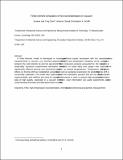Finite Element Simulation of Hot Nanoindentation in Vacuum
Author(s)
Lee, Hunken; Chen, Ying; Claisse, Antoine; Schuh, Christopher A.
Download11340_2012_9700_ReferencePDF.pdf (649.9Kb)
OPEN_ACCESS_POLICY
Open Access Policy
Creative Commons Attribution-Noncommercial-Share Alike
Terms of use
Metadata
Show full item recordAbstract
A finite element model is developed to investigate technical issues associated with hot nanoindentation measurements in vacuum, e.g. thermal expansion-induced drift and temperature variations at the contact region between the cold indenter tip and hot specimen. With heat conduction properly accounted for, the model is able to reasonably reproduce experimental indentation measurements on fused silica and copper—two materials with significantly different thermal and mechanical properties—at several temperatures. Temperature and loading rate effects on thermal drift are established using this model and an analytical expression for predicting thermal drift is numerically calibrated. The model also captures details of the indentation process that are not directly accessible experimentally, and reaffirms the need for operational refinements in order to acquire high temperature indentation data of high quality, especially in a vacuum environment. Such information can guide experiments aimed at understanding thermally-activated phenomena in materials.
Date issued
2013-02Department
Massachusetts Institute of Technology. Department of Materials Science and EngineeringJournal
Experimental Mechanics
Publisher
Springer US
Citation
Lee, H., Y. Chen, A. Claisse, and C.A. Schuh. “Finite Element Simulation of Hot Nanoindentation in Vacuum.” Experimental Mechanics 53, no. 7 (February 5, 2013): 1201–1211.
Version: Author's final manuscript
ISSN
0014-4851
1741-2765